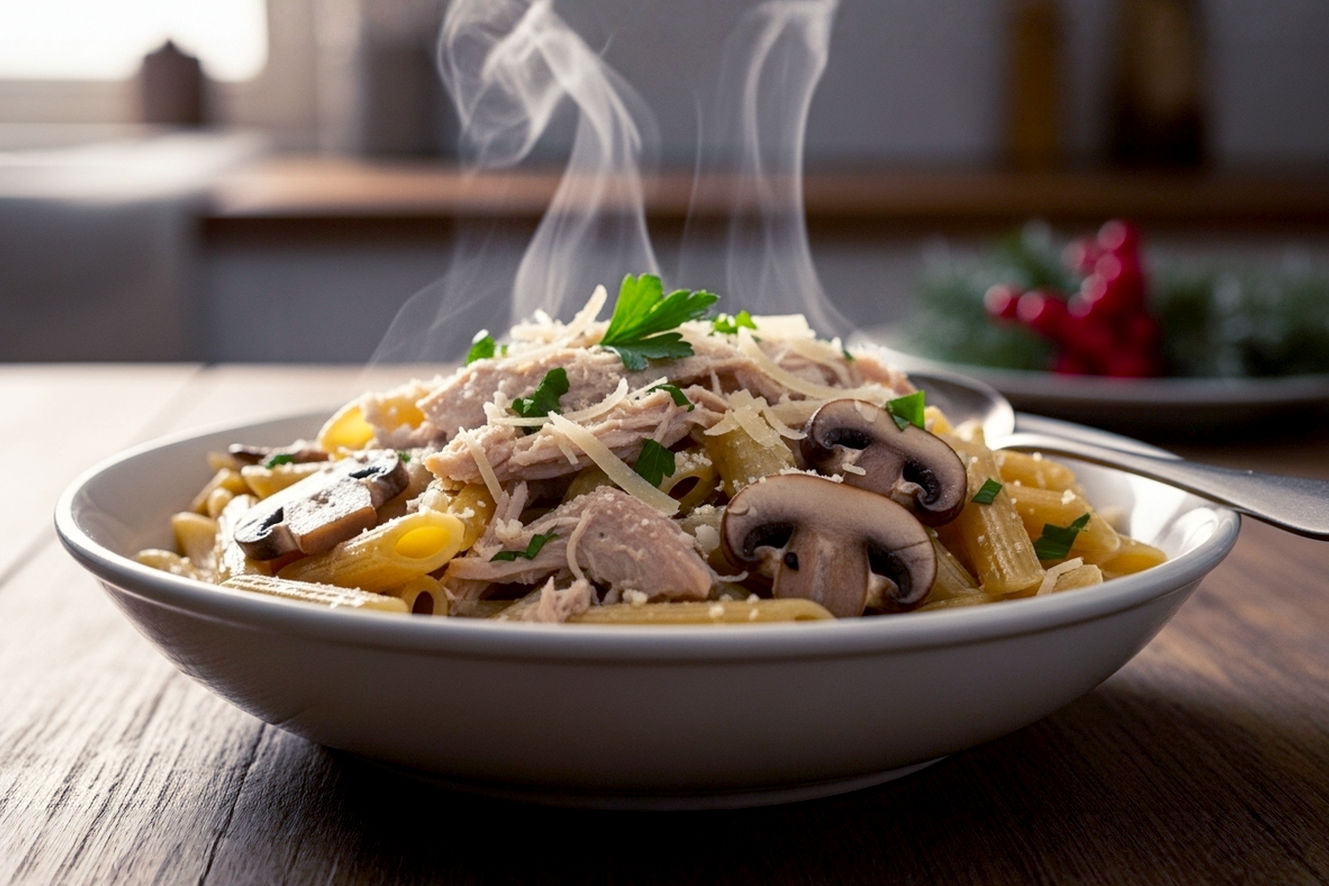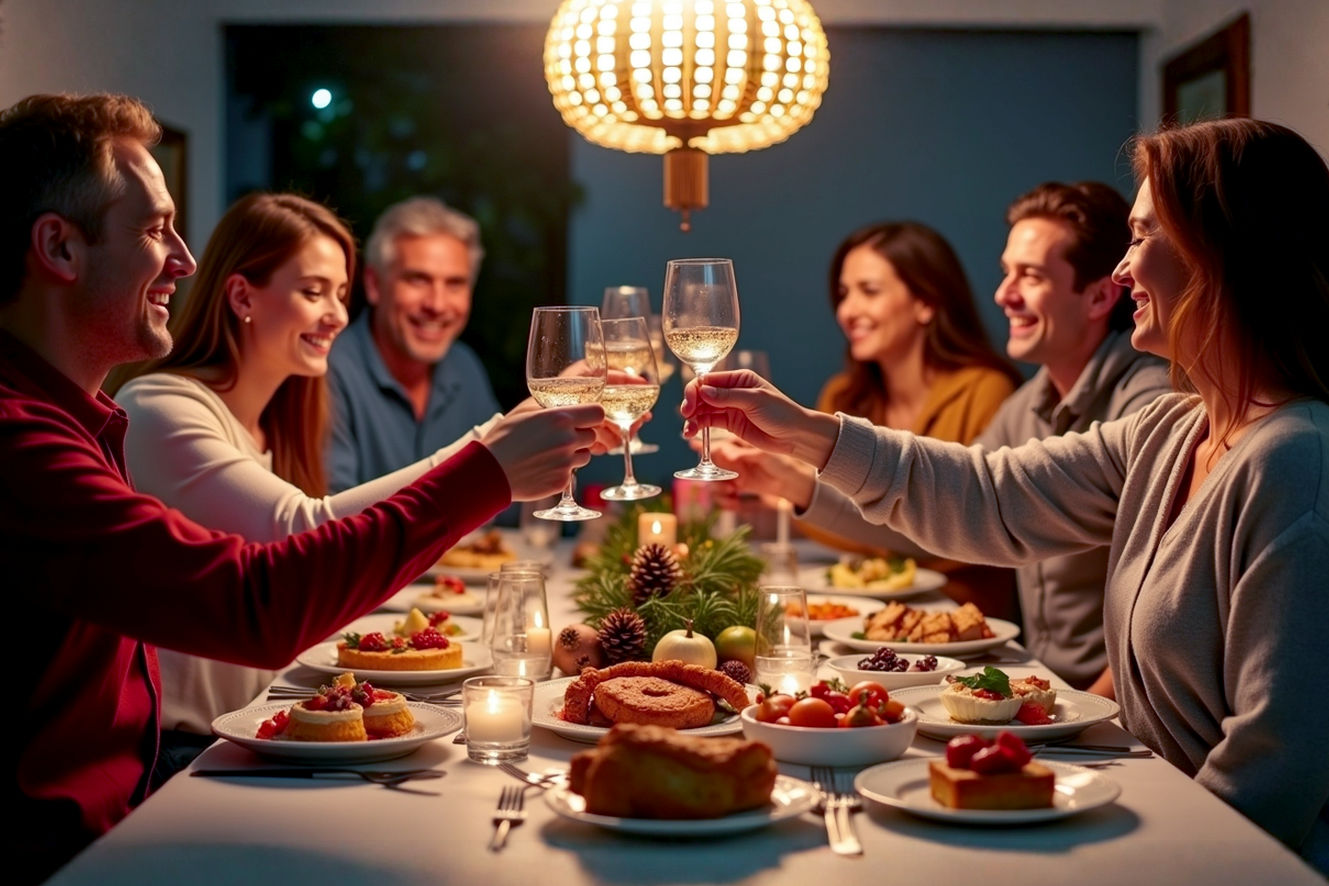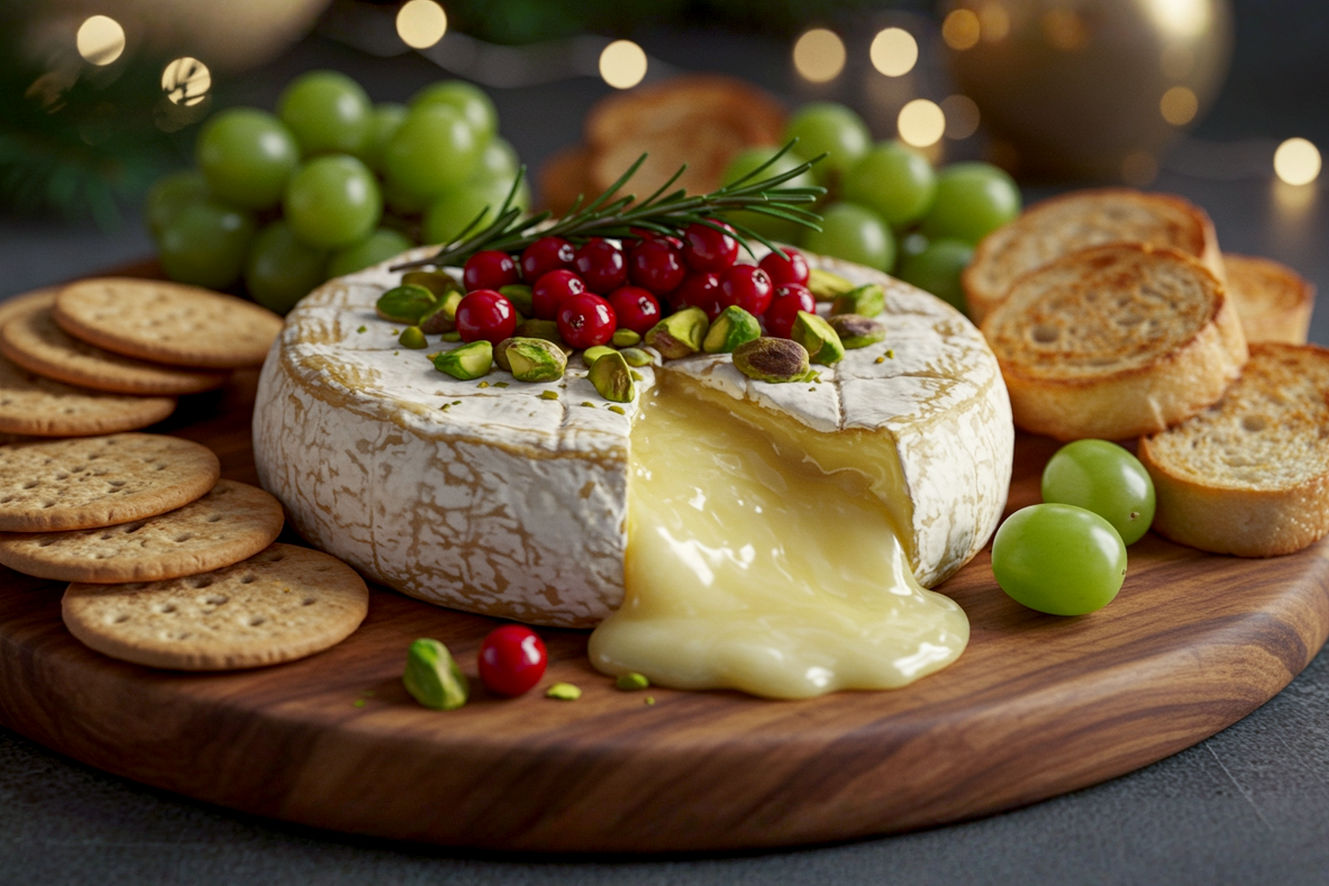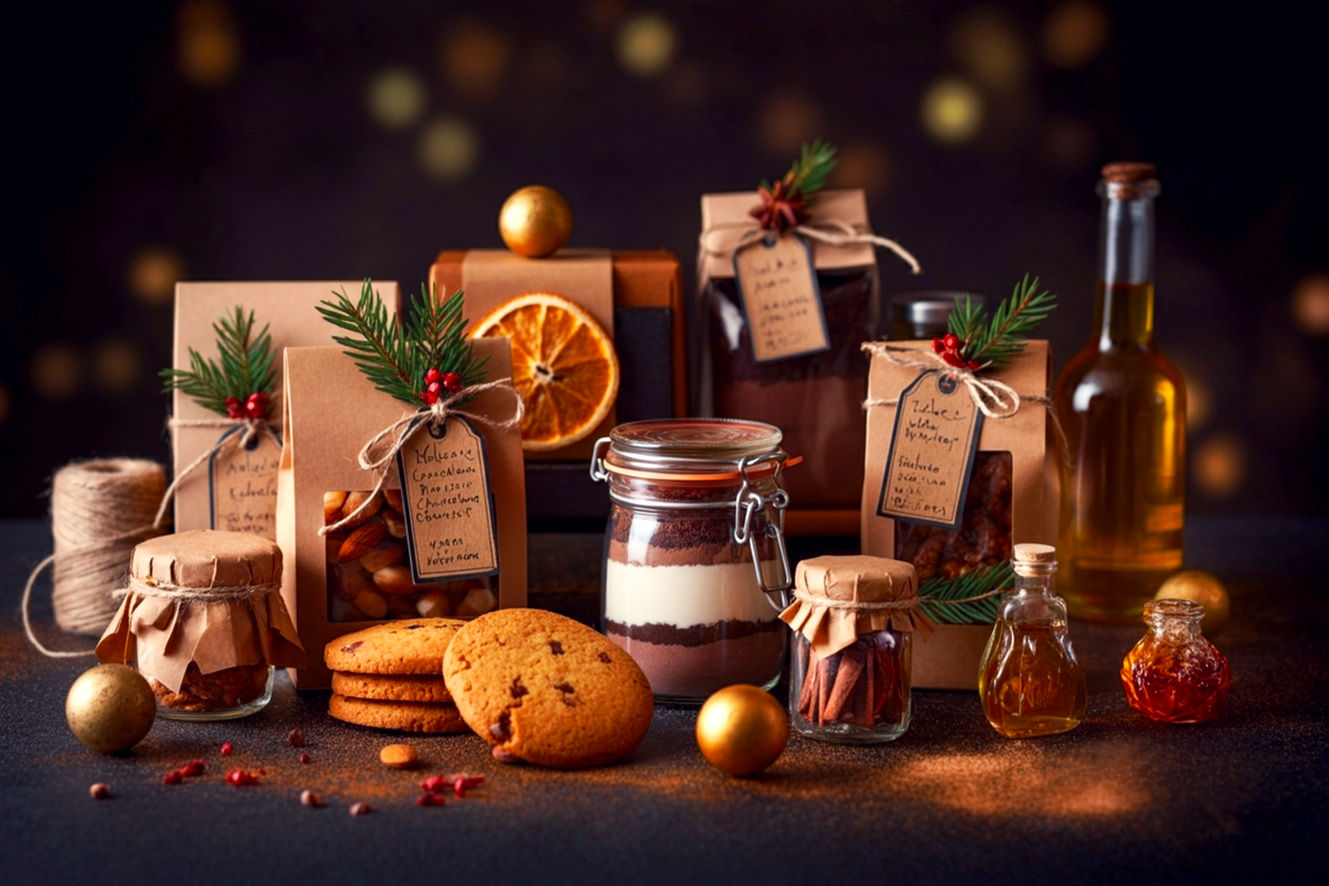This post may contain affiliate links. If you make a purchase through these links, we may earn a commission at no additional cost to you.
Christmas in Italy, known as Natale, isn’t just a single day; it’s a season-long celebration deeply rooted in family, tradition, and, most importantly, incredible food. Unlike many other cultures, Italian Christmas dining often involves two distinct, elaborate feasts: one on Christmas Eve and another on Christmas Day.
These meals are more than just sustenance; they’re expressions of love, heritage, and regional identity. You’ll find families gathering for hours, sharing stories, laughter, and an abundance of meticulously prepared dishes passed down through generations. Hosting an authentic traditional Italian Christmas dinner means more than simply cooking a few recipes. It involves understanding the cultural nuances, the rhythm of the meal, and the specific dishes that define this cherished holiday across Italy’s diverse regions. It’s about creating an atmosphere where food serves as the central pillar of connection and celebration.
This guide will walk you through everything you need to know to host a truly authentic Italian Christmas dinner. We’ll explore the historical significance of the feasts, delve into the iconic dishes from various regions, and provide practical tips for planning, preparing, and presenting a memorable holiday meal that will transport your guests straight to the heart of Italy. Get ready to embrace the spirit of Natale and create a culinary experience your family and friends won’t soon forget.
The Heart of Italian Christmas: La Vigilia and Natale
The Italian Christmas celebration is primarily defined by two major culinary events: La Vigilia on Christmas Eve and Natale on Christmas Day. These aren’t just meals; they are deeply ingrained traditions that reflect centuries of cultural and religious practices. Understanding the purpose and structure of each feast is crucial for hosting an authentic experience.
La Vigilia: The Feast of the Seven Fishes (Christmas Eve)
Christmas Eve, known as La Vigilia (The Vigil), is a time of anticipation and a culinary tradition that stands apart from the rich, meat-heavy meals often associated with Christmas. This evening feast is famously known as the “Feast of the Seven Fishes,” especially among Southern Italian and Italian-American communities.
Historical and Religious Significance
The tradition of La Vigilia stems from the Catholic practice of abstinence from meat on the eve of a major religious holiday. This “lean day” or giorno di magro was meant to purify the body and prepare the soul for the spiritual significance of Christmas Day. While the original intent was fasting, over centuries, it evolved into an elaborate seafood banquet. The number seven, often associated with the seven sacraments, the seven virtues, or the seven days of creation, became symbolic, leading to the “Seven Fishes” tradition. However, it’s important to note that the exact number of dishes can vary widely by family and region, sometimes ranging from three to thirteen or even more. The core idea remains: a meatless meal featuring a variety of fish and seafood. This practice highlights the deep connection between faith and food in Italian culture, where culinary traditions often intertwine with religious observances.
The Seven Fishes Tradition: What It Means
The Feast of the Seven Fishes isn’t about strict adherence to exactly seven specific fish. Instead, it emphasizes variety and abundance of seafood. Families might serve a mix of fried, baked, stewed, and raw seafood dishes. Common choices include baccalà (salted cod), fried calamari, mussels, clams, shrimp, octopus, and various white fish. Each dish showcases different preparation methods and flavors, creating a diverse and exciting spread. For example, you might start with a light seafood salad, move to a pasta dish with clams (spaghetti alle vongole), and then enjoy fried calamari or baked fish as a main course. The emphasis is on fresh, high-quality ingredients and the communal joy of sharing a bountiful table with loved ones. It’s a testament to the ingenuity of Italian cuisine, transforming a day of abstinence into a lavish celebration of the sea’s bounty.
Natale: The Grand Christmas Day Feast (Christmas Day)
After the seafood-centric La Vigilia, Christmas Day, Natale, brings a shift to a hearty, indulgent, and often meat-focused feast. This is the main event for many Italian families, a grand lunch that can last for hours, filled with rich flavors and robust dishes.
Family, Indulgence, and Celebration
Christmas Day lunch is a time for ultimate indulgence and family togetherness. It’s a leisurely affair, often starting around noon and extending well into the late afternoon or early evening. The atmosphere is festive and warm, with tables laden with food, wine flowing freely, and conversations buzzing. This meal is a celebration of abundance, a stark contrast to the “lean” meal of the night before. It’s a time when families gather, often with multiple generations around a single table, to share traditional recipes, exchange gifts, and simply enjoy each other’s company. The focus shifts from the sea to the land, featuring rich meats, comforting pastas, and decadent desserts. This communal dining experience reinforces family bonds and creates cherished memories that last a lifetime.
Regional Variations on Christmas Day
While the general theme of a grand, meat-centric meal holds true for Christmas Day, the specific dishes vary significantly across Italy’s twenty regions. Italy’s culinary landscape is incredibly diverse, and Christmas menus are a perfect reflection of this regionality. In the North, you might find rich broths with stuffed pastas like tortellini in brodo and hearty boiled meats (bollito misto). Central Italy often features roasted lamb (abbacchio) or pork (arista) and baked pastas. In the South, while Christmas Eve is heavily seafood, Christmas Day can still include some fish, but also robust meat sauces, sausages, and unique local specialties. This regional diversity means there isn’t one single “Italian Christmas dinner” but rather a mosaic of culinary traditions, each reflecting the local produce, historical influences, and unique flavors of its specific area. Understanding these differences allows for a truly authentic and personalized Christmas menu.
Crafting Your Authentic Italian Christmas Menu
Building an authentic Italian Christmas menu means creating a multi-course experience that balances flavors, textures, and traditions. Each course plays a specific role, contributing to the overall narrative of the meal.
Antipasti: The Welcoming Spread
The meal always begins with antipasti, literally “before the meal.” This course sets the tone, offering a delightful array of small bites designed to whet the appetite and encourage conversation. It’s a chance to showcase a variety of flavors and textures.
Essential Cured Meats and Cheeses
For Christmas Day, a selection of high-quality cured meats and cheeses is a must. Think thinly sliced prosciutto di Parma or San Daniele, savory salame, and perhaps a spicy coppa. Pair these with a variety of Italian cheeses: a firm, aged Parmigiano Reggiano, a creamy fresh mozzarella or burrata, and a tangy pecorino. Offer some breadsticks (grissini) or crusty artisan bread alongside. The saltiness of the cured meats and the richness of the cheeses create a perfect flavor harmony, stimulating the palate without being too heavy. This combination provides a classic Italian start to any festive gathering, offering both familiar comfort and sophisticated flavors.
Seafood Delights for La Vigilia
On Christmas Eve, the antipasti shift to seafood. You might include a vibrant insalata di mare (seafood salad) with calamari, shrimp, and octopus dressed simply with lemon and olive oil. Fried small fish, like crispy fried anchovies or fritto misto (mixed fried seafood), are also popular. Marinated anchovies or sardines can offer a briny counterpoint. These dishes are light yet flavorful, adhering to the meatless tradition of La Vigilia while still being festive and appealing. The freshness of the seafood is paramount, ensuring a clean and bright start to the evening’s feast.
Vegetable-Based Starters
Beyond meats and seafood, vegetable-based antipasti are versatile and can be served on either Christmas Eve or Christmas Day. Marinated artichoke hearts, roasted red peppers, sun-dried tomatoes, and a variety of olives are classic choices. Bruschetta topped with fresh tomatoes and basil, or a creamy fagioli all’uccelletto (cannellini beans with sage and tomato) can add warmth and substance. Stuffed mushrooms or fried zucchini flowers also make elegant and flavorful additions. These vegetable dishes provide balance to the richer elements of the meal, offering fresh, earthy, and sometimes tangy notes that cleanse the palate and prepare it for the courses to come.
Primi: The Soulful First Courses
The primi are the heart of the Italian meal, typically a pasta, risotto, or soup dish. These courses are often the most comforting and regionally distinctive.
Pasta in Brodo: A Northern Italian Staple
In Northern Italy, especially Emilia-Romagna, tortellini in brodo (small, meat-filled pasta served in a rich capon or beef broth) is an iconic Christmas Day primo. The delicate pasta and savory broth offer warmth and a sense of tradition. Other similar options include cappelletti or agnolotti in broth. This dish is a testament to the region’s rich culinary heritage, where handmade pasta and slow-simmered broths are elevated to an art form. The broth is often prepared days in advance, allowing its flavors to deepen and mature, providing a truly comforting and deeply flavorful start to the main Christmas meal.
Baked Pasta: Southern and Central Comfort
In Central and Southern Italy, baked pasta dishes (pasta al forno) are often the star of the Christmas Day primo. Lasagna (with meat ragù, béchamel, and cheese) is a universal favorite, but variations like cannelloni or manicotti filled with ricotta and spinach, or a rich meat sauce, are also common. These dishes are perfect for feeding a crowd and can often be prepared in advance, making them practical for a large holiday gathering. The layers of pasta, rich sauce, and melted cheese create a satisfying and indulgent experience, embodying the warmth and generosity of Italian hospitality. Each region might have its own specific version, incorporating local cheeses or unique spice blends, adding to the dish’s distinct character.
Seafood Pastas for Christmas Eve
For La Vigilia, pasta dishes featuring seafood are essential. Spaghetti alle vongole (spaghetti with clams in a white wine and garlic sauce) is a classic, light yet incredibly flavorful choice. Other popular options include linguine ai frutti di mare (linguine with mixed seafood) or pasta with a simple tomato and cod sauce. These dishes highlight the freshness of the seafood, allowing its natural flavors to shine through, complemented by herbs, garlic, and sometimes a hint of chili. They provide a substantial yet meat-free primo, perfectly fitting the traditions of Christmas Eve. The simplicity of preparation often belies the depth of flavor, making these dishes both elegant and satisfying.
Secondi: The Heart of the Meal
The secondi are the main course, typically a meat or fish dish, often served simply to highlight the quality of the primary ingredient.
Robust Meats for Christmas Day
On Christmas Day, the secondi are usually hearty meat dishes. In Northern Italy, bollito misto (a selection of boiled meats like beef, veal, and chicken, often served with various sauces like salsa verde) is a traditional, labor-intensive dish. Roasted meats are also popular across Italy: arista (roast pork loin) in Tuscany, agnello al forno (roast lamb) in Central and Southern Italy, or even a roasted capon. These dishes are often slow-cooked or roasted to perfection, resulting in tender, flavorful meat that forms the centerpiece of the festive table. They represent the culmination of the Christmas Day feast, offering rich, satisfying flavors that are deeply comforting and celebratory.
Iconic Seafood Mains for La Vigilia
For La Vigilia, the secondi continue the seafood theme. Baccalà (salted cod) is a ubiquitous choice, prepared in countless ways: fried, stewed with tomatoes and potatoes, or baked. Capitone (eel), often roasted or fried, is a traditional but increasingly less common dish, particularly in Southern Italy. Fried calamari or a whole baked fish like branzino (sea bass) are also popular. These dishes are typically served simply, allowing the quality of the seafood to be the star. The preparation methods vary from light and crispy frying to slow simmering in aromatic sauces, providing a range of textures and flavors within the meatless meal.
Contorni: Complementary Side Dishes
Contorni are the side dishes that accompany the main course, providing balance and additional flavors. They are often simple yet essential.
Traditional Vegetable Preparations
Roasted potatoes, often seasoned with rosemary and garlic, are a universal favorite. Sautéed greens like spinach (spinaci saltati) or broccoli rabe (broccoli rabe saltati) are common, offering a slightly bitter counterpoint to richer dishes. Artichokes, prepared in various ways (fried, braised, or roasted), are also a festive addition. A simple mixed green salad dressed with olive oil and vinegar provides freshness. These vegetable dishes are typically prepared with minimal fuss, allowing the natural flavors of the produce to shine. They add color, texture, and nutritional balance to the substantial main courses.
Legumes for Luck and Prosperity
In some regions, particularly on New Year’s Eve but also occasionally at Christmas, lentils are served, often with cotechino or zampone (types of large sausages). Lentils symbolize prosperity and good luck for the coming year due to their coin-like shape. While more common for New Year’s, their presence at a Christmas meal can add a symbolic touch and a hearty, earthy element to the contorni. This tradition highlights the cultural belief in food as a harbinger of fortune, making the meal not just delicious but also meaningful.
Dolci: The Sweet Grand Finale
No Italian meal, especially a Christmas feast, is complete without a lavish spread of dolci (desserts). This course is a true celebration of sweetness and often features iconic holiday pastries.
Panettone vs. Pandoro: The Great Debate
The two undisputed kings of Italian Christmas desserts are Panettone and Pandoro. Panettone, originating from Milan, is a tall, dome-shaped sweet bread filled with candied fruits and raisins. It has a light, airy texture and a distinctive aroma. Pandoro, from Verona, is a star-shaped, golden, buttery sweet bread, typically dusted with powdered sugar and without candied fruit. The choice between Panettone and Pandoro is a friendly rivalry across Italy, with families often serving both to satisfy all preferences. Both are traditionally enjoyed with a glass of sparkling wine or a sweet dessert wine. These cakes are not just desserts; they are symbols of the Italian Christmas season, found in nearly every home during the holidays.
Regional Dessert Specialties
Beyond Panettone and Pandoro, Italy boasts a wealth of regional Christmas desserts. In Naples, struffoli are small, deep-fried dough balls coated in honey and adorned with colorful sprinkles, often piled high to resemble a Christmas tree. Siena offers panforte, a dense, chewy fruitcake packed with nuts, candied fruit, and spices, and ricciarelli, soft almond cookies. Sicily is famous for its cannoli (crisp pastry shells filled with sweetened ricotta cheese) and cassata siciliana (a rich sponge cake with ricotta, candied fruit, and marzipan). Each region’s desserts tell a story of local ingredients and historical influences, adding unique flavors to the festive table.
Other Festive Sweets
Other common Christmas sweets include torrone (nougat made with honey, nuts, and egg whites, varying from soft to hard), biscotti of various kinds, and dried fruits and nuts. These smaller treats provide additional options for guests and are perfect for nibbling alongside coffee or digestifs after the main dessert. The variety ensures that there is something for everyone, from rich and creamy to light and crispy, making the dessert course a true highlight of the Italian Christmas experience.
Digestivi: The Perfect End to a Feast
To conclude such a grand meal, Italians traditionally offer digestivi (digestives)—liqueurs or spirits believed to aid digestion. Popular choices include limoncello (a bright lemon liqueur), amaro (a bitter herbal liqueur), or grappa (a potent grape-based spirit). These are typically served in small glasses, sipped slowly, and provide a pleasant, warm finish to the extensive meal. They are a final act of hospitality, signaling the transition from formal dining to relaxed conversation and enjoyment.
Regional Flavors: A Culinary Journey Across Italy
Italy’s culinary identity is deeply regional, and nowhere is this more evident than in its Christmas traditions. Each area boasts unique dishes, reflecting local ingredients, historical influences, and family customs.
Northern Italy: Rich Broths and Stuffed Pastas
Northern Italy, with its colder climate, favors hearty, warming dishes, often featuring butter, rich broths, and elaborate stuffed pastas.
Emilia-Romagna: Tortellini and Cotechino
Emilia-Romagna, often called Italy’s food valley, is famous for its exquisite pasta. On Christmas Day, tortellini in brodo (small, meat-filled pasta in a rich capon or beef broth) is a sacred tradition in Bologna and Modena. These tiny, handmade pasta parcels are a labor of love, symbolizing family and celebration. For the secondo, cotechino (a large, slow-cooked pork sausage) served with lentils is a popular choice, especially on New Year’s Eve, but also seen at Christmas. The lentils, shaped like coins, symbolize prosperity for the coming year. This region’s cuisine is characterized by its richness and its devotion to traditional, high-quality ingredients.
Piedmont: Bagna Cauda and Bollito Misto
In Piedmont, a unique and communal dish called bagna cauda is often served as an antipasto or even a main course. This “hot sauce” is a warm, savory dip made from garlic, anchovies, and olive oil, served with an array of raw and cooked vegetables for dipping. It’s a robust, flavorful dish perfect for sharing. For the main course, bollito misto (mixed boiled meats) is a grand affair. This dish involves various cuts of beef, veal, and chicken, slowly simmered to tenderness, and often served with an assortment of sauces like salsa verde (green sauce with parsley, capers, and anchovies) or mostarda (candied fruit in a mustard-flavored syrup). It’s a testament to the region’s agricultural bounty and its tradition of slow, comforting cooking.
Lombardy and Veneto: Panettone and Pandoro’s Homelands
Lombardy is the birthplace of Panettone, the iconic dome-shaped sweet bread with candied fruits and raisins. While enjoyed nationwide, its origins are firmly rooted in Milanese tradition. Veneto, on the other hand, is home to Pandoro, the star-shaped, golden, buttery sweet bread, particularly associated with Verona. Both sweet breads are central to Christmas celebrations across Italy, but their regional origins highlight the distinct baking traditions of these northern areas. Beyond these famous desserts, the regions also feature rich risottos and polenta dishes in their Christmas menus.
Central Italy: Hearty Roasts and Rustic Dishes
Central Italy’s cuisine often reflects its agricultural landscape, featuring hearty roasts, simple yet flavorful pasta dishes, and rustic vegetable preparations.
Lazio (Rome): Lamb and Classic Lasagna
In Rome and the Lazio region, abbacchio (roasted milk-fed lamb) is a quintessential Christmas Day main course. The lamb is typically seasoned simply with rosemary, garlic, and white wine, then slow-roasted until tender and succulent. For the primo, a rich lasagna or cannelloni is a popular choice, often made with a meat ragù and béchamel sauce. Roman Christmas meals emphasize robust flavors and comforting, familiar dishes that bring families together. The focus is on quality ingredients and time-honored cooking methods that highlight the natural goodness of the produce.
Tuscany: Crostini and Roast Fowl
Tuscany’s Christmas table often features crostini di fegatini (toasted bread slices topped with a rich chicken liver pâté) as an antipasto. This rustic yet elegant starter showcases the region’s love for simple, flavorful ingredients. For the main course, roasted game fowl, such as guinea fowl or even wild boar, might be served, reflecting the region’s hunting traditions. The emphasis in Tuscan Christmas cuisine is on high-quality, locally sourced ingredients prepared in a way that highlights their natural flavors, often with fresh herbs and olive oil.
Southern Italy: Seafood Extravaganza and Vibrant Flavors
Southern Italy, with its extensive coastline, is renowned for its seafood, especially on Christmas Eve. Its cuisine is vibrant, often featuring tomatoes, olive oil, and fresh herbs.
Campania (Naples): Seafood and Struffoli
Naples, in Campania, is a stronghold of the Feast of the Seven Fishes. Christmas Eve is a grand seafood affair, with dishes like spaghetti alle vongole (spaghetti with clams), fried baccalà, and fritto misto di mare (mixed fried seafood). The emphasis is on fresh, abundant seafood prepared in various ways. For dessert, struffoli are a must: tiny, deep-fried dough balls coated in honey and decorated with colorful sprinkles, often piled into a festive pyramid. These sweet, crunchy bites are a beloved Neapolitan tradition, symbolizing sweetness and joy.
Sicily: Sardines and Cannoli
In Sicily, Christmas Eve might feature sarde a beccafico (stuffed sardines), a flavorful dish that showcases the island’s unique blend of Arab and European influences. The sardines are typically filled with breadcrumbs, pine nuts, raisins, and herbs, then baked or pan-fried. For dessert, cannoli (crisp fried pastry shells filled with sweetened ricotta cheese, often with candied fruit or chocolate chips) and cassata siciliana (a rich, ornate cake with ricotta, marzipan, and candied fruit) are iconic. Sicilian Christmas food is characterized by its bold flavors, fresh seafood, and rich, often elaborate, pastries.
Calabria and Puglia: Unique Regional Staples
Calabria and Puglia, in the “toe” and “heel” of Italy, also feature strong seafood traditions for La Vigilia. In Calabria, fried zeppole (savory or sweet fried dough) might appear. Puglia is known for cartellate (rose-shaped fried pastries drizzled with honey or fig syrup) and pettole (small fried dough balls). These regions demonstrate the incredible diversity even within Southern Italy, each adding its own distinct flavors and preparations to the Christmas table. The use of local produce, olive oil, and sometimes spicy elements characterizes their festive cuisine.
Planning and Hosting Your Italian Christmas Dinner
Hosting an authentic Italian Christmas dinner is a rewarding endeavor that requires careful planning and a relaxed approach. It’s about creating an atmosphere where guests feel cherished and the food is celebrated.
Setting the Scene: Ambiance and Decor
The ambiance is just as important as the food. Italians value conviviality and warmth, so create a welcoming environment that encourages lingering and conversation.
The Importance of the Table
The dining table is the focal point of the celebration. Set it with your best linens, elegant dinnerware, and sparkling glassware. A festive centerpiece, perhaps with candles, fresh greenery, or even small bowls of traditional Christmas nuts and dried fruits, adds to the holiday spirit. Consider using colors associated with Italian Christmas, such as rich reds, deep greens, and crisp whites. The table should feel abundant and inviting, signaling the feast to come. This attention to detail elevates the meal from simply eating to a true dining experience.
Festive Decorations and Music
Beyond the table, subtle decorations can enhance the Italian Christmas atmosphere. Think natural elements like pine cones, holly, and twinkling lights. Avoid overly commercial or flashy decor. Playing traditional Italian Christmas music, or even classic Italian opera or folk music, can transport your guests culturally. The goal is to create a cozy, festive, and authentic Italian feel, where the focus is on warmth, family, and the joy of the season. The music should be background, allowing conversation to flow easily, but present enough to set the mood.
Essential Kitchen Preparations
An Italian Christmas dinner is a marathon, not a sprint. Strategic kitchen preparation is key to a smooth and enjoyable experience for both you and your guests.
Ingredient Sourcing and Quality
The cornerstone of Italian cuisine is high-quality, fresh ingredients. Source the best olive oil, fresh seafood, artisanal pasta, and premium meats you can find. Visit local markets or specialty Italian delis for authentic cheeses, cured meats, and unique regional ingredients. Don’t compromise on quality, as the simplicity of many Italian dishes means the ingredients truly shine. For example, using fresh, ripe tomatoes for a sauce will yield a vastly different and superior flavor compared to canned, low-quality alternatives. This dedication to quality is a hallmark of authentic Italian cooking.
Timing and Flow: A Multi-Course Marathon
An Italian Christmas dinner is typically a multi-course affair, often lasting several hours. Plan your menu with dishes that can be prepared in stages. Some antipasti can be assembled in advance, and many baked pasta dishes can be prepared the day before and simply reheated. Broths for tortellini in brodo can be simmered for hours, developing deep flavors. Consider the cooking times and temperatures for your main courses to ensure everything is ready at the right moment. Don’t try to make everything from scratch on the day of the feast. Delegate tasks if possible, and embrace the “slow food” philosophy, allowing plenty of time between courses for conversation and enjoyment. A well-planned timeline will reduce stress and allow you to enjoy the celebration along with your guests.
Wine Pairings: Elevating the Experience
Wine is an integral part of Italian dining, and thoughtful pairings can significantly enhance your Christmas feast.
Sparkling Wines for Aperitivo
Begin your meal with a sparkling wine like Prosecco or Franciacorta. These light, effervescent wines are perfect for aperitivo, stimulating the palate and setting a celebratory mood as guests arrive. Their crispness and subtle fruit notes complement a wide range of antipasti, from cured meats to fried seafood. The bubbles also add a festive touch, signaling the start of a special occasion.
White Wines for Seafood
For La Vigilia or any seafood courses on Christmas Day, opt for crisp, dry white wines. A Vermentino from Liguria or Sardinia, a Pinot Grigio from Veneto, or a Verdicchio from Marche would be excellent choices. These wines have sufficient acidity and minerality to cut through the richness of fried fish or complement the delicate flavors of shellfish without overpowering them. They enhance the natural sweetness of the seafood and provide a refreshing contrast.
Red Wines for Meat Courses
For the hearty meat courses on Christmas Day, choose robust red wines. A Chianti Classico or Brunello di Montalcino from Tuscany pairs beautifully with roasted lamb or pork. For richer dishes like bollito misto or beef, a Barolo or Barbaresco from Piedmont, or an Amarone della Valpolicella from Veneto, would be exceptional. These wines, with their firm tannins and complex fruit notes, stand up to the richness of the meat and complement savory sauces. The general rule of thumb is to pair regional food with regional wine, ensuring a harmonious match.
Sweet Wines for Dessert
Conclude your meal with a sweet wine that complements the dolci. A lightly sparkling Moscato d’Asti is wonderful with Panettone or Pandoro, offering a delicate sweetness and effervescence. For richer, nuttier desserts like panforte or torrone, a Vin Santo from Tuscany (a sweet, amber-colored dessert wine) is a traditional and exquisite pairing. These sweet wines provide a luxurious finish, balancing the flavors of the desserts and leaving a lasting impression.
Hosting Tips for a Seamless Celebration
Beyond the menu and wine, a few hosting strategies can make your Italian Christmas dinner truly special and stress-free.
Embracing the “Slow Food” Philosophy
Italian dining is rarely rushed. Embrace the “slow food” philosophy, allowing ample time for each course. Encourage guests to linger, converse, and savor each dish. This unhurried pace is central to the Italian way of life and makes the meal a truly relaxing and enjoyable experience. Don’t feel pressured to clear plates immediately or rush to the next course. The beauty is in the shared time and conversation around the table.
Involving Family and Friends
In Italian culture, cooking and dining are often communal activities. Don’t hesitate to involve family and friends in the preparation. Assign simple tasks like setting the table, chopping vegetables, or preparing a specific antipasto. This not only lightens your load but also makes guests feel more invested in the meal and the celebration. It fosters a sense of shared effort and strengthens bonds, embodying the true spirit of family.
Handling Dietary Preferences
While traditional Italian Christmas dinners are often meat or fish-centric, it’s important to be mindful of dietary preferences or restrictions. Offer at least one vegetarian antipasto and primo option. For La Vigilia, the seafood nature naturally accommodates those who don’t eat meat. For Christmas Day, consider a substantial vegetable side dish or a vegetarian baked pasta. Communicate with your guests beforehand to ensure everyone feels comfortable and well-fed. Small adjustments can make a big difference in ensuring all your loved ones can fully participate in the feast.
Beyond the Meal: Italian Christmas Traditions
The food is undeniably central, but Italian Christmas traditions extend beyond the dining table, enriching the overall holiday experience. Integrating these elements can make your celebration even more authentic.
Presepe: The Nativity Scene
The presepe (nativity scene) is a cornerstone of Italian Christmas decor, often more prominent than a Christmas tree in many homes. Originating with St. Francis of Assisi, the presepe depicts the birth of Jesus, often with intricate details and figures representing everyday life in an Italian village. Setting up a presepe in your home, perhaps with figures collected over the years, adds a profound sense of tradition and spiritual meaning to your celebration. Families often gather around the presepe to sing carols or tell stories, making it a focal point for quiet reflection and shared wonder.
Midnight Mass and Family Gatherings
For many devout Italian families, attending Midnight Mass on Christmas Eve is a cherished tradition. This spiritual observance often precedes or follows La Vigilia, reinforcing the religious significance of the holiday. On Christmas Day, after the grand lunch, families typically relax together, playing card games like Scopa or Briscola, enjoying board games, or simply conversing. This time for leisure and connection is as important as the meal itself, allowing everyone to unwind and enjoy each other’s company without the pressure of formal activities. It’s a time for quiet joy and deep familial bonds.
Gift Exchange and Post-Feast Relaxation
Gift-giving in Italy often takes place on Christmas Day, sometimes after the main lunch or in the evening. Children might open presents brought by Babbo Natale (Father Christmas) or La Befana (an old woman who brings gifts on Epiphany, January 6th, in some regions). After the extensive meal, a period of relaxation is essential. This might involve sipping digestivi, enjoying leftover Panettone or Pandoro, or simply lounging and chatting. The emphasis is on unwinding and savoring the holiday spirit, reflecting the Italian appreciation for leisure and the enjoyment of life’s simple pleasures, especially when shared with loved ones.
Conclusion: A Feast for the Senses and the Soul
Hosting an authentic traditional Italian Christmas dinner is a journey into the heart of Italian culture. It’s a celebration that transcends mere eating, becoming a rich tapestry of flavors, aromas, and cherished traditions. From the seafood bounty of La Vigilia to the hearty indulgence of Christmas Day, each dish tells a story of regional heritage and familial love. By carefully selecting your menu, embracing the multi-course rhythm, and creating a warm, inviting atmosphere, you’re not just serving a meal; you’re creating an immersive experience.
Remember, authenticity lies not just in the recipes but in the spirit of generosity, conviviality, and unhurried enjoyment. Take pride in sourcing quality ingredients, allow ample time for preparation and enjoyment, and most importantly, savor the moments shared around the table with your loved ones. This Christmas, let your home be filled with the warmth, laughter, and unforgettable flavors of a truly Italian Natale. Buon Natale!






